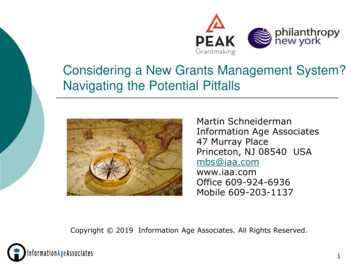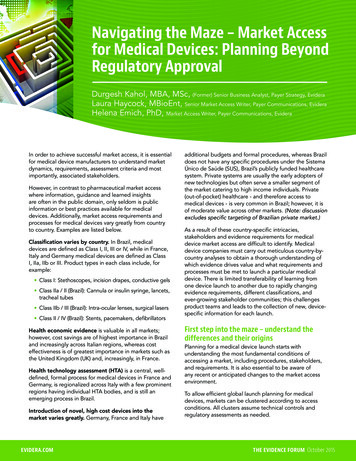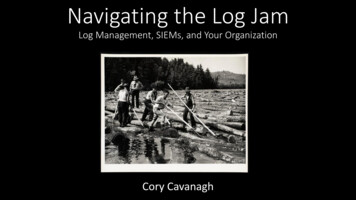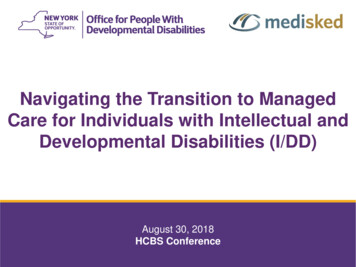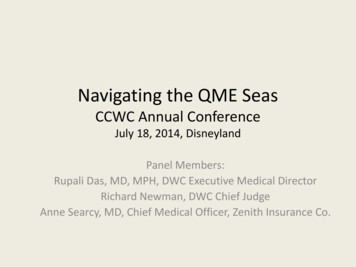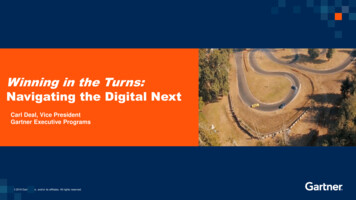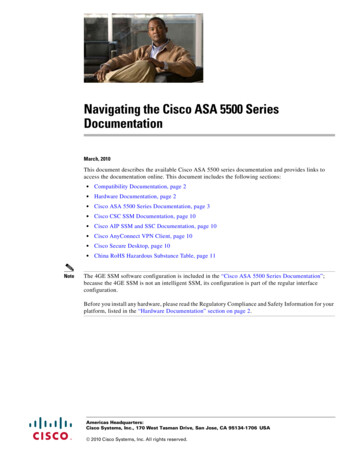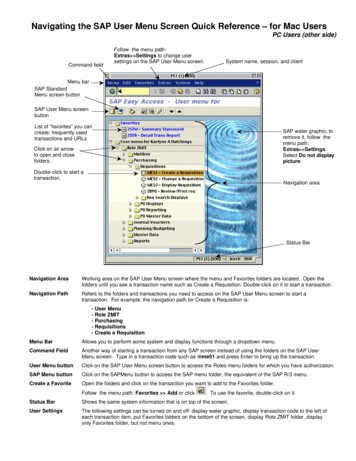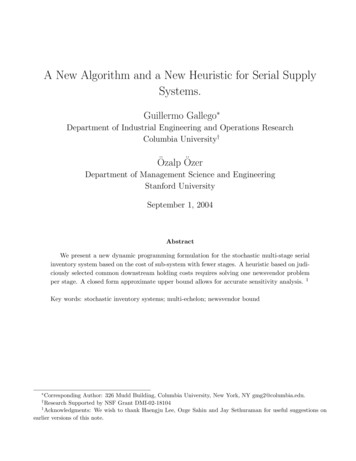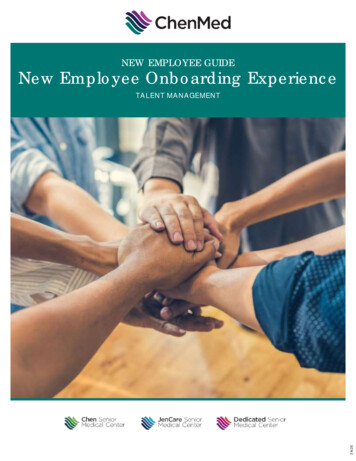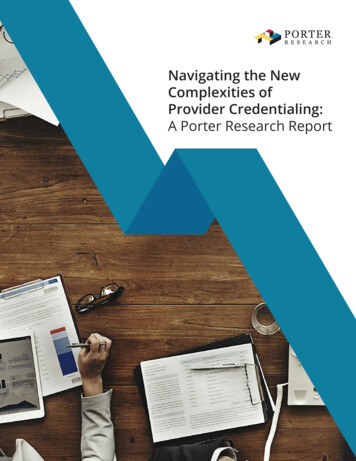
Transcription
Navigating the NewComplexities ofProvider Credentialing:A Porter Research Report
Navigating the New Complexities of Provider CredentialingINTRODUCTIONIt’s no secret that virtually every component of theand standardizing data that comes in throughhealthcare industry is undergoing massive disruptionhundreds of different sources and in differentdue to rapidly evolving regulatory and reimbursementformats can be overwhelming, particularly forenvironments. The provider data management space,organizations seeking new economies of scale fromalso known as the provider credentialing data andacquisitions. For standalone hospitals that are oftenservices space, is no exception.strapped for IT and credentialing expertise, stayingahead of the onslaught of federal and stateThis once relatively quiet, highly administrativeguidelines associated with provider credentialing isfunction within hospitals is now under the spotlight toa constant challenge.help improve patient safety and protect organizationsfrom fraudulent activity while also identifying newBut as the pressure mounts, provider dataefficiencies that support cost containment andmanagement vendors are responding with newquality goals.innovations and working to consolidate their ownindustry. Over the past several years, the softwareAs a result, data management software vendorsvendor landscape has changed dramatically withwho historically focused on supporting the physicianseveral of the well-established players, such ascredentialing function have stretched beyond theirsymplr (formerly Cactus and Vistar) and Verity, aoriginal scope to help hospitals address other aspectsHealthStream company (formerly Echo and Morrissey)of preventing fraud. In addition, many of theseacquiring legacy platforms, and new entrants haveorganizations have invested heavily in changingemerged onto the scene. Many companies have alsothe market dynamics in their favor—from makingdelivered SaaS-based solutions and new services.acquisitions to rolling out new cloud-based platformsand value-added services.All of this disruption has made it more difficultchallenged when it comes to integrating multiple“Credentialing is the process ofobtaining, verifying, and assessing thequalifications of a practitioner to providecare or services in or for a health careorganization. Credentials are documentedevidence of licensure, education, training,experience, or other qualifications.”facilities, systems, workflows and staff. Synchronizing– Joint Commissionfor today’s busy hospital CIO to evaluate the rightprovider data management solution for theirorganization. CIOs and medical staff team membersinvolved in mergers and acquisitions are particularly 2018 Porter Research, All Rights Reserved2
Navigating the New Complexities of Provider CredentialingWhile this is typical behavior in a mature, denselyCapturing input from 528 credentialing professionalspopulated market segment (consider financialfrom 446 unique organizations including 35 healthservices and retail industries), the landscape canplans, the research looked at everything fromseem treacherous for the buyers and users ofvendor market share to the most popular likes andprovider credentialing tools and services. Thedislikes about current solutions. Hospital respondersuncertainty of the future of the legacy, acquiredrepresented all types of organizations: multi-hospitalplatforms can freeze purchase decisions and institutesystems (49%), single hospitals (31%) and physiciana “wait and see” mentality among buyers. As moregroups (15%) (Figure 1). Health plans representedorganizations are forced to migrate off of their oldboth commercial (67%) and provider health plansplatforms, they may also take the opportunity to(19%) (Figure 2).evaluate all other options in the market.This paper seeks to provide greater clarity on theIt is this disruption and rapidly changing softwarecurrent landscape and offer practical advice forvendor landscape that drove Porter Research totoday’s CIO who is charged with evaluating theexplore the current provider data managementcomplex provider data management market.landscape through the industry’s largest researchinitiative to date.Figure 1: Healthcare provider respondentsrepresent both single and multi-hospital angroupsHEALTHCAREPROVIDERS31%Single hospitalsFigure 2: Health plan respondents werepredominately from commerical organizations19%Provider ial 2018 Porter Research, All Rights Reserved3
Navigating the New Complexities of Provider CredentialingKEY OBSERVATIONS FROM THE RESEARCHMature market dynamics with a narrowingnumber of software vendorsthey have been on the same system for 6-10 years.This indicates that the market has not been activelyevaluating new solutions, either due to the lack ofNearly 90% of respondents are currently using a dataattention paid to this area of the business or overallmanagement tool today, with the remaining 10%satisfaction with their current software vendor, orrelying on their own systems and spreadsheets. Thissome combination of factors.reflects a mature, saturated market in which vendorsmust differentiate themselves on value-addedThere are a handful of software organizations whoservices, while providers must sift through subtlehold the lion’s share of the market. Each of the majordifferences in core capabilities.vendors has played a critical role in consolidating themarket. See the timeline below to betterIn addition, very few providers have switchedunderstand the complexities of the consolidatingsolutions in the last five years, with 30% ofvendor landscape.respondents reporting that they have been usingtheir current solution for 10 years and 25% reporting198219851986 Cactus Software andHealthline Systemsfounded19972010Intellisoft Groupacquired CambronCredentials2012Modio Health founded Morrissey AssociatesfoundedApplied Statistics andManagement (ASM)foundedIntellisoft Group andVistar Technologiesfounded2014HealthStream acquiresSy. Med201520162017 symplr acquires CactusSoftware HealthStream acquiresMorrissey HealthStream acquiresHealth Line Systems HealthStreamannounces Echo symplr formed bymerger of Medkinetics(pay or enrollmentservices and vendorcredentialing services) HealthStream launchesVerity (new solutionfor Echo, Sy. Med andMorrissey customers) symplr acquires VistarTechnologies/eVIPs ASM launches MDStaff 2018 Porter Research, All Rights Reserved4
CURRENT MARKET SHARE OF SOFTWARE VENDORS ACROSSTHE HEALTHCARE INDUSTRYWhen asked which provider data managementBased on the sample size, Porter believes thesesystems they use, respondents answered therepresent the current market share of softwarefollowing way:vendors across the industry.Which tools does your organization currently use for provider data management?2%Spreadsheets1%Credentialing Doc2%Homegrown wn mplr/Vistar 2018 Porter Research, All Rights Reserved5
Navigating the New Complexities of Provider CredentialingA seasoned workforce provides deepdomain expertise but creates long-term risksof staff shortageNearly half of respondents (48%) reported that theyhave been working in credentialing or health planenrollment for 10 years, and only 13% reportedbeing in the field for less than two years. Additionally,66% of respondents spend more than 50% of theirday using their provider data management tools.While these results indicate that the survey feedbackreceived came from highly experienced medical staffworkers and leaders, they also indicate that skilledWith new technology advancements, providers andworkers may be aging with very few new entrantshealth plans should embrace the opportunity tointo the profession. A shortage of resources withautomate many of the historically manual processescredentialing and compliance expertise could be onassociated with provider data management to reducethe horizon, and some believe it is already here.labor costs and reduce their risk of not having accessto experienced resources in the future.How long have you worked in providercredentialing and/or payer enrollment?Vendor innovation outpacing user adoptionIn the open-ended questions in the research, manyorganizations reported that they were not using the13%0-2 yearslatest version of their systems and/or not using their48%10 years15%6-10 yearsA SEASONEDWORKFORCEsystem to its fullest potential. There appears to be anumber of reasons for this, ranging from the cost ofupgrading to a lack of resources available to makethe move. This can impede customer satisfaction andlimit the positive impact the solution can have on thehospital’s workflow and cost savings. With so muchinnovation going on among vendors, perhaps greaterattention should be paid to helping current customers23%3-5 yearsadopt and optimize use of these new capabilities. 2018 Porter Research, All Rights Reserved6
PRIMARY FUNCTIONS OF DATA MANAGEMENT SOLUTIONSIt’s more than just credentialingAs the provider data management market hasfor today, it came as no surprise that the top businessmatured, software vendors have added morefunction was credentialing, with 92% of the providercapabilities that demonstrate the value they deliver.respondents and 92% of health plans reporting so.When asked about the primary functions thatWhen we look beyond credentialing, the next mostrespondents use their data management solutionspopular business functions reported were:How does your organization use your current provider data management tools?AMONG PROVIDERSAMONG plicationmanagement64%Providerdirectories56%Peer 7%Committeemanagement48%010203040500102030 2018 Porter Research, All Rights Reserved40507
Navigating the New Complexities of Provider CredentialingINDUSTRY DRIVERS IMPACTING THE SOFTWAREVENDOR LANDSCAPESo what’s behind all of these changing marketdemanding a single source of truth for physician data,dynamics that are pushing vendors to offerpressures are mounting for software providers tocapabilities beyond credentialing and to stretchdeliver more capabilities and greater standardizationacross the provider data management continuum?across the enterprise.Even though the world of physician credentialing hasAs the digital transformation of healthcarenot changed much over the past decade, the public’stakes hold, healthcare providers are sitting onability to easily access information about physiciansterabytes of data that can be found across theirand hospitals has changed dramatically. Whetherorganizations—tucked away in thousands ofthrough CMS’s physiciancompare.com service,spreadsheets and emails or buried deep within theGoogle profiles, or mass media coverage, the court ofEHR billing systems of their various hospitals.public opinion represents a real threat to hospitals’reputations, finances, or even accreditations.As CIOs and healthcare leaders seek to find a singleCredentialing practices and technologies are nowsource of truth for provider credentialing efforts,working their way to the top of hospital CIOs’the need to centralize disparate data sources into aworry list.single system is growing in importance. CIOs mustmatch the complexities of today’s provider dataAs healthcare providers start to emerge from themanagement solutions with the capabilities theydepths of EHR implementations andbelieve their organizations can handle.Meaningful Use attestations (now referred to asPromoting Interoperability), IT leaders are ableto focus on other areas of the business, such asleveraging the large sets of physician data they nowstandards in place. As IT leaders are being held“Health insurance companiesare streamlining credentialingof physicians who contract withMedicaid health plans in hopesof boosting doctor participationin the program that provides carefor the poor.”accountable for the validity of different data sources– Forbes, April 2018possess to support a more thorough and efficientcredentialing process.Physician data is collected and used by virtuallyevery department, but there are typically very fewacross their enterprises and business leaders are 2018 Porter Research, All Rights Reserved8
Navigating the New Complexities of Provider CredentialingA LOOK AHEAD: FIVE CONSIDERATIONS FOR SELECTINGYOUR FUTURE PROVIDER DATA MANAGEMENT PLATFORMAs we’ve stated, the provider data management spaceassistance from their vendors whenis undergoing significant change, and it is likely todesigning business processes that are sure tocontinue to do so over the next three to five years.check all of the right boxes and capture all ofEver-increasing regulatory requirements and massivethe right information.reimbursement changes are expected to continue toput pressure on healthcare providers’ bottom lines.For providers, top vote-getters for areas ofimprovement were very similar to the healthAs providers and health plans turn their attentionplans, but interoperability and more completeto the many disparate data sets they now own, it isand consistent data standards emerged asimportant for today’s CIO to consider thetop wants.following factors when selecting a provider datamanagement solution.1.2.Total cost of ownership must beconsidered. In recent years, healthcare CIOsOne size does not fit all. Leaders shouldhave begun to accept the benefits and risks ofbe careful not to generalize data managementcloud-based solutions. They are being forced tosoftware solutions, as their needs are verylook at every way to cut overhead costs whiledifferent based on the size and complexity ofalso protecting their organization and patienttheir organizations, as well as the availability ofdata under the stringent privacy and dataIT and credentialing expertise. storage laws. Maintaining and protecting datain their own server rooms is no longer realistic,For example, in the survey, the most commonlyand many are making the decision tomentioned improvements that health plansoutsource this function to organizations thatwould like to see from their software vendorsspecialize in this. were better reporting, improved ease of use,more business process automation and greaterWhen considering non-cloud-based solutions,flexibility. In terms of process automation,it is important for CIOs to understand the fullthe constantly changing business structurescost of ownership, including the impact to theirand regulatory requirements make it difficultown data centers, software upgrades and ITfor users to comply with business protocolsoversight, all of which are typically rolled intoand procedures. Health plans want and needthe cost of a cloud solution. 2018 Porter Research, All Rights Reserved9
Navigating the New Complexities of Provider Credentialing3.Evaluate the track record of innovation5.Gain visibility into a vendor’sand investment. Forward-thinking softwareinteroperability strategy. With the massivevendors with a track record of investingdata silos that exist across all healthcarein capabilities and solutions are likely theproviders today, having a system that canones who will survive in the long run. Wheneasily exchange data with third-party systemsevaluating solution partners, inquire about ais critical. For example, Cactus provides nativevendor’s previous two to three years’ worthintegrations off the shelf as well as an API thatof innovations, and seek to understand theallows its customers to easily build functionalitycommitted product roadmap for the next twoaround the solution. This is particularly handyto three years. One year is not enough. Askfor some health plans that are starting toyourself if these advancements align withdelegate credentialing where there is a highwhere your organization is going, and whetherdegree of trust between their organization andyou trust that your solution provider isa hospital network that they know does a goodcapable of staying on top of the ever-changingjob of credentialing its physicians. In exchange,regulatory requirements.the hospital network may see benefits suchas higher reimbursement rates. As all players4.Consider opportunities for userengagement. Providers should seek to partnerwith software vendors that demonstrateactive involvement with their user bases, suchacross the healthcare spectrum seek to containcosts and limit risks, these relationships canbe mutually beneficial for those who are gettingit right.as through a public feedback system, userThe provider data management vendor landscapeconferences and advisory boards. Forward-is undergoing significant change, and hospital CIOsthinking organizations that participate in broadmust be aware of the advantages and risks associatedindustry meetings and work groups and whowith a move to a more modern solution.demonstrate a thirst for understanding howemerging technologies, such as blockchainand artificial intelligence (AI), will impact theircustomers are typically a good fit for mid- andlarge-size hospitals as they tend to have theirfinger on the pulse of innovation. 2018 Porter Research, All Rights Reserved10
Navigating the New Complexities of Provider Credentialing: A Porter Research ReportABOUT PORTER RESEARCHCONTACTPorter Research works with growth-mindedPorter Researchcompanies to develop and execute market research 678-427-6241programs and create strategies using market info@porterresearch.comintelligence uncovered. With 30 years of experience,we have worked with more than 300 IT companies,and complete thousands of interviews each year.This means we know your industry, we know howyou need to use the data, and we execute the rightresearch program to uncover what you can’t find onyour own. We also apply the data to help you developactionable plans and strategies to achieve your goals.Learn more at www.porterresearch.com.info@porterresearch.com porterresearch.com 678-427-6241
strapped for IT and credentialing expertise, staying ahead of the onslaught of federal and state guidelines associated with provider credentialing is a constant challenge. But as the pressure mounts, provider data management vendors are responding with new innovations and working to
